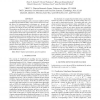Free Online Productivity Tools
i2Speak
i2Symbol
i2OCR
iTex2Img
iWeb2Print
iWeb2Shot
i2Type
iPdf2Split
iPdf2Merge
i2Bopomofo
i2Arabic
i2Style
i2Image
i2PDF
iLatex2Rtf
Sci2ools
110
click to vote
ICASSP
2011
IEEE
2011
IEEE
Exemplar-based Sparse Representation phone identification features
Exemplar-based techniques, such as k-nearest neighbors (kNNs) and Sparse Representations (SRs), can be used to model a test sample from a few training points in a dictionary set. In past work, we have shown that using a SR approach for phonetic classification allows for a higher accuracy than other classification techniques. These phones are the basic units of speech to be recognized. Motivated by this result, we create a new dictionary which is a function of the phonetic labels of the original dictionary. The SR method now selects relevant samples from this new dictionary to create a new feature representation of the test sample, where the new feature is better linked to the actual units to be recognized. We will refer to these new features as Spif . We present results using these new Spif features in a Hidden Markov Model (HMM) framework for speech recognition. We find that the Spif features allow for a 2.9% relative reduction in Phonetic Error Rate (PER) on the TIMIT phonetic re...
Related Content
| Added | 21 Aug 2011 |
| Updated | 21 Aug 2011 |
| Type | Journal |
| Year | 2011 |
| Where | ICASSP |
| Authors | Tara N. Sainath, David Nahamoo, Bhuvana Ramabhadran, Dimitri Kanevsky, Vaibhava Goel, Parikshit M. Shah |
Comments (0)

